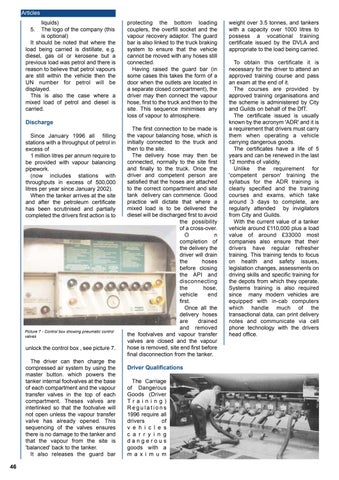Articles liquids) The logo of the company (this is optional) It should be noted that where the load being carried is distillate, e.g. diesel, gas oil or kerosene but a previous load was petrol and there is reason to believe that petrol vapours are still within the vehicle then the UN number for petrol will be displayed. This is also the case where a mixed load of petrol and diesel is carried. 5.
protecting the bottom loading couplers, the overfill socket and the vapour recovery adaptor. The guard bar is also linked to the truck braking system to ensure that the vehicle cannot be moved with any hoses still connected. Having raised the guard bar (in some cases this takes the form of a door when the outlets are located in a separate closed compartment), the driver may then connect the vapour hose, first to the truck and then to the site. This sequence minimises any loss of vapour to atmosphere.
Discharge Since January 1996 all filling stations with a throughput of petrol in excess of 1 million litres per annum require to be provided with vapour balancing pipework. (now includes stations with throughputs in excess of 500,000 litres per year since January 2002). When the tanker arrives at the site and after the petroleum certificate has been scrutinised and partially completed the drivers first action is to
Picture 7 - Control box showing pneumatic control valves
unlock the control box , see picture 7. The driver can then charge the compressed air system by using the master button. which powers the tanker internal footvalves at the base of each compartment and the vapour transfer valves in the top of each compartment. Theses valves are interlinked so that the footvalve will not open unless the vapour transfer valve has already opened. This sequencing of the valves ensures there is no damage to the tanker and that the vapour from the site is 'balanced' back to the tanker. It also releases the guard bar
46
The first connection to be made is the vapour balancing hose, which is initially connected to the truck and then to the site. The delivery hose may then be connected, normally to the site first and finally to the truck. Once the driver and competent person are satisfied that the hoses are attached to the correct compartment and site tank delivery can commence. Good practice will dictate that where a mixed load is to be delivered the diesel will be discharged first to avoid the possibility of a cross-over. O n completion of the delivery the driver will drain the hoses before closing the API and disconnecting the hose, vehicle end first. Once all the delivery hoses are drained and removed the footvalves and vapour transfer valves are closed and the vapour hose is removed, site end first before final disconnection from the tanker.
Driver Qualifications The Carriage of Dangerous Goods (Driver Training) Regulations 1996 require all drivers of v e h i c l e s c a r r y i n g dangerous goods with a m a x i m u m
weight over 3.5 tonnes, and tankers with a capacity over 1000 litres to possess a vocational training certificate issued by the DVLA and appropriate to the load being carried. To obtain this certificate it is necessary for the driver to attend an approved training course and pass an exam at the end of it. The courses are provided by approved training organisations and the scheme is administered by City and Guilds on behalf of the DfT. The certificate issued is usually known by the acronym 'ADR' and it is a requirement that drivers must carry them when operating a vehicle carrying dangerous goods. The certificates have a life of 5 years and can be renewed in the last 12 months of validity. Unlike the requirement for 'competent person' training the syllabus for the ADR training is clearly specified and the training courses and exams, which take around 3 days to complete, are regularly attended by invigilators from City and Guilds. With the current value of a tanker vehicle around £110,000 plus a load value of around £33000 most companies also ensure that their drivers have regular refresher training. This training tends to focus on health and safety issues, legislation changes, assessments on driving skills and specific training for the depots from which they operate. Systems training is also required since many modern vehicles are equipped with in-cab computers which handle much of the transactional data, can print delivery notes and communicate via cell phone technology with the drivers head office.





